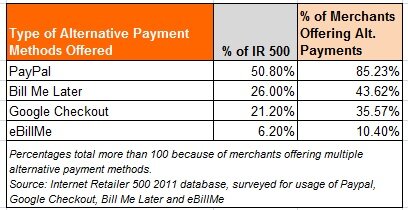Winning sales from abandoned carts, 3: Email best practices
January 30, 2012 Leave a Comment
In the past couple of posts, we’ve looked at how techniques on the eCommerce site and retargeting advertisements can recover sales from visitors who’ve abandoned their shopping carts — a potentially lucrative audience that includes 88% of U.S. consumers, according to industry researcher Forrester.
But the most commonly-known technique for reconnecting with cart abandoners is via email — with merchants sending follow-up reminders to shoppers to entice them back to the site and complete their purchases. Although well understood, this tactic still isn’t widely-used: a recent study by email services firm Listrak found that just 18.5% of merchants in the Internet Retailer 500 — that’s less than 1 in 5 — use email to reengage with cart abandoners. The number is even lower for merchants in Internet Retailer’s Second 500 ranking of smaller merchants, Listrak found — just 10.7%.
For merchants who do deploy cart-abandonment recovery campaigns, the payoff can be significant. Food purveyor SmileyCookie.com reported recapturing 29% of abandoned carts — nearly 1 in 3 — with a targeted series of three emails. And remarketing services company SeeWhy found that abandonment email campaigns recover more than 20% of sales on average, and generate a whopping $17.90 per email sent — much higher than typical non-targeted email promotions.
With results like that, merchants should make deploying cart recovery emails a top priority for 2012. To implement effective an effective program, consider these tactics:
Collect email addresses early, but avoid forced account creation.
In order to send cart abandoners a targeted email enticing them back to the site, merchants need to have captured their email addresses in the first place. Increasingly, merchants are attempting to collect addresses via forced account creation — but with 14% of shoppers reporting that a lack of guest checkout drove them to abandon carts in the first place, according to Forrester, we don’t recommend resorting to such extremes. Instead, use subtler methods to capture this information:
- Link abandoned carts to email subscribers. Use behavioral tracking technology to flag when a shopper who’s signed up for email updates, then goes on to abandon a shopping cart.
- Ask for an email address in the very first step of checkout, and explain why. Collect an email address on the initial checkout screen, and clearly state it will be used to contact shoppers if there is a question about their order. Include links to privacy information to boost trust, as Walmart does on the first step of guest checkout.

Send a reminder immediately, then follow up.
Fully 54% of cart abandoners who intend to buy will do so in the first 24 hours after leaving the site, SeeWhy found. Another 10% will act within 48 hours; within a week, 82% of those who intend to buy will have pulled the trigger. With the gains after the first 24 hours being incremental, it’s crucial to trigger follow-up emails promptly — sending the first within an hour or two of cart abandonment and the second within a day.
In the case study cited above, SmileyCookie.com sent its first email within 30 minutes of abandonment; the second 23 hours later; and the final message four days later. The first email garnered the highest open and click-through rates.
Message content: don’t default to a discount …
When sending shoppers abandonment email offers, the temptation is strong to offer a discount, such as free shipping, to help close the sale. But such immediate payoffs can “train” shoppers to abandon carts in anticipation of a discount. Instead, experiment with the following messaging:
- Stress service and convenience. With 11% of cart abandoners reporting they found the checkout process confusing and 10% saying they didn’t have enough information to complete their purchases, offering customer service assistance is a smart strategy to win sales.
-
- Phrasing such as “can we help you complete your order?” puts the emphasis on service.
- Include email, phone and live chat options as available.
- Spotlight available alternative payment methods such as Paypal, which can save time in checkout.
Sears sends abandoners a service-oriented message that displays how shoppers can “buy your way” (via phone or using a personal online shopper), “pay your way” (using alternative payments), and “deliver your way” (with site-to-store and home delivery options) — thereby addressing a series of potential checkout stumbling blocks.

- Give shoppers product alternatives. Many cart abandoners are “window shopping” by adding items to the cart, without necessarily being enamored enough of the chosen product to commit: Forrester found that 24% of abandoners added items to the cart just to be able to consider them later, and 41% weren’t ready to purchase. So give these ambivalent shoppers a sampling of alternative products that might better suit their needs, as Urban Outfitters does in the message below, showing not only the abandoned item but others “you may also like.”

… but do clearly reiterate standard promotions.
If you normally offer free shipping above a threshold, or free site-to-store delivery, do spotlight these policies in your abandonment messaging; cart abandoners may have missed such offers while shopping the eCommerce site, and a prominent reminder of potential savings can trigger them to return and commit to buy.
In the examples above, Sears highlights the availability of free site-to-store delivery, while Urban Outfitters reminds cart abandoners that shipping is free with a purchase of $150 or more. Neither merchant is creating a new discount to lure abandoners back — merely restating sitewide policies the recipients may have forgotten since leaving the site.
For more examples of abandonment emails, view Listrak’s Abandonment Look Book. What messaging and timing strategies have worked for your brand to recapture abandoned carts?







 Our hunch was confirmed when we crunched numbers from
Our hunch was confirmed when we crunched numbers from  Not only do the majority of IR 500 merchants offer alternative payments, but most of those who do so — 53.9% — offer more than one such service, giving shoppers maximum flexibility when completing transactions.
Not only do the majority of IR 500 merchants offer alternative payments, but most of those who do so — 53.9% — offer more than one such service, giving shoppers maximum flexibility when completing transactions.





Connect with us: